Fort of Gwalior – “Gibraltar of India”

Gwalior is a major city in the central Indian state of Madhya Pradesh and one of the counter-magnet cities. The city and its fortress have been ruled by many northern Indan kingdoms. Fort of Gwalior is one of the biggest forts in India and positioned on an isolated rock mass that houses a number of historic buildings. Spread across a huge area of 3 sq km, this fort is made of red sandstone. There are two doors in one north-east and one in the south-west. The name of the main gate is the elephant bridge and the second gate is named Badalgarh.
This fortress has been integral to the history of the North Indian kingdoms and has been described as “The pearl in the necklace of the forts of Hind” in the words of the Mughal Emperor Babur. Many rulers of different periods captured the fort and have seen many battles including the battles related to independence from the British. This majestic fort is a wonder of a bygone era in the form of a wealth of art and architecture.
History of Gwalior Fort
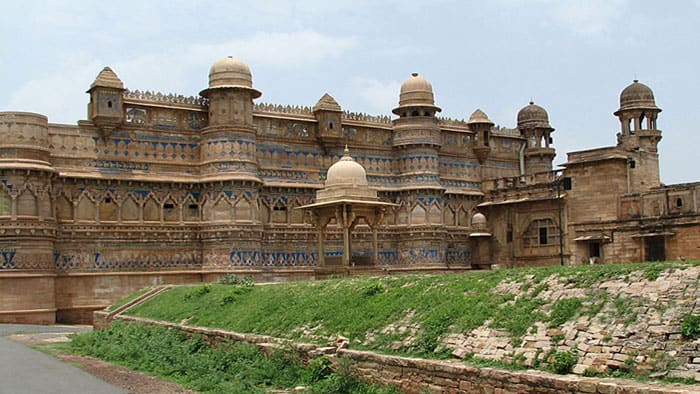
The history of Fort of Gwalior goes back a long way with the earliest record of the fort is 525 AD, although the proper fort has been built in the 8th century. The Fort itself was built in two parts, at different times. In the first part, the main Fort was built during the Tomar rule, in the 8th century. Raja Man Singh Tomar constructed the Gurjari Mahal and the Man Mandir Palace in the 15th century for his favorite queen, Mrignayani. The fort is located on a hillock overlooking Gwalior all around. The main gate of the fort is called Hathi Pol (“elephant gate“) as an elephant could pass through it.
The fort has seen the rise and fall of several dynasties. According to a local legend, the fort was built in 3 CE by a local king named Suraj Sen. He was cured of leprosy when a sage named Gwalippa offered him water from the sacred pond, which is now located within the fort. The grateful king built a fort and named it after the sage. The sage conferred upon the king the title of Pal (“protector”) and told him that the fort would remain in the possession of his family as long as he would hold this title. 83 descendants of Suraj Sen Pal controlled the fort, but the 84th Teej Karan Naam lost it.
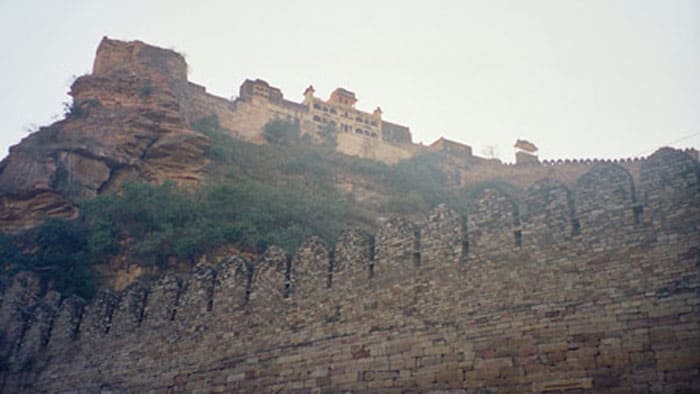
The inscriptions and monuments found inside the fort complex now indicate that it existed in the early 6th century. An inscription from Gwalior describes a Sun Temple built in the 6th century during the reign of Huna Emperor Mihirkula. The temple of Teli, now situated within the fort, was built in the 9th century by the Gurjara-Pratiharas.
The fort certainly existed until the 10th century, when it was first mentioned in historical records. Kachhapaghat controlled the fort at this time, probably as feudatories of the Chandelas. From the 11th century, Muslim dynasties attacked the fort several times. In 1022 AD, Mahmud of Ghazni laid siege to the fort for four days. According to Tabqat-e-Akbari, he laid siege to pay tribute to 35 elephants. General Qutub al-Din Aibak of Ghurid, who later became the ruler of the Delhi Sultanate, captured the fort in 1196 after a long siege. 1232 AD The Delhi Sultanate lost the fort for a short time before being ousted by Iltumish.
In 1398, the fort came under the control of the Tomars. The most eminent among the Tomar rulers was Man Singh, who commissioned several monuments within the fort. Delhi Sultan Alexander Lodi tried to capture the fort in 1505 but was unsuccessful. Another attack by his son Ibrahim Lodi in 1516, resulted in the death of Man Singh. The Tomars eventually handed over the fort to the Delhi Sultanate after a year of siege.
Within a decade, the Mughal emperor Babur captured the fort from the Delhi Sultanate. The Mughals lost the fort in 1542 to Sher Shah Suri. Later, the fort was used by Hemu, the Hindu general, and the Hindu ruler of Delhi for many of his campaigns, but Babur’s grandson Akbar withdrew it in 1558. Akbar made the fort a prison for political prisoners. For example, Abul-Qasim, the son of Kamran and Akbar’s first cousin, was placed in the fort and killed.
Guru Hargobind, on 24 June 1606, at the age of 11, became the sixth Sikh Guru. In his succession ceremony, he employed two swords: one indicated his spiritual authority (Piri) and the other, his temporal right (Miri). Due to the execution of Guru Arjan by the Mughal emperor Jahangir, Guru Hargobind was a devoted enemy of Mughal rule from the beginning.
He advised the Sikhs to wield weapons and fight. The death of his father at the hands of Jahangir prompted him to emphasize the military dimension of the Sikh community. While making fun of 14-year-old Guru Hargobind at the fort of Gwalior in 1609, Jahangir replied that the penalty imposed on Guru Arjan was not paid by the Sikhs and Guru Hargobind. It is unclear how much time he spent as a prisoner.
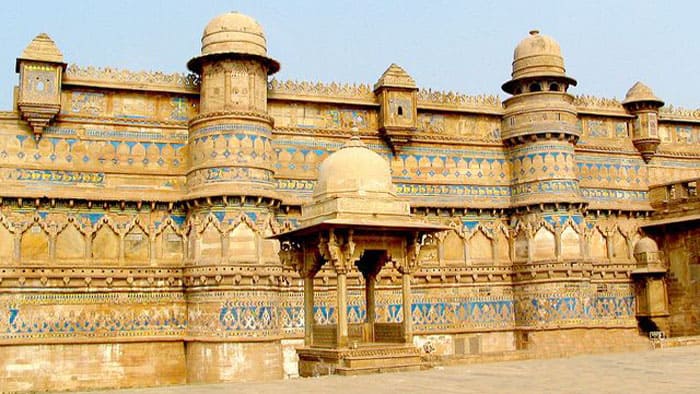
The year of his release was either 1611 or 1612 when Guru Hargobind was around 16 years old. Persian records, such as Dabistan I Mazahib suggest that he was kept in prison for twelve years, including 1617–1619 in Gwalior, after which he and his camp were kept under the supervision of the Muslim army by Jahangir. According to Sikh tradition, Guru Hargovind was released from prison confinement on Diwali. This important event of Sikh history is now called Bandi Chhor Divas Utsav.
Aurangzeb’s brother, Murad, and nephews Suleman and soldier Shikoh were also killed in the fort. The murders took place in the Man Mandir Palace. After the death of Aurangzeb, the Rana chieftains of Gohad took over the fort of Gwalior. Maratha general Mahadaji Shinde (Scindia) captured the fort from Gohad Rana Chhatar Singh but soon lost it to the British East India Company.
On 3 August 1780, the British captured the Gwalior fort by a half-night guerrilla war led by Captain Popham and Bruce. In 1780, Governor Warren Hastings gave Gohad Rana back the rights to the fort. After 4 years, the Marathas again took possession of the fort. This time the British did not interfere because they had been deceived by Gohar Rana. Daulat Rao Scindia lost this fort again in the second Maratha-British war.
Between 1808 and 1844, control of this fort continued to come into the hands of the Marathas and sometimes the British. After the battle of Maharajpur, in January 1844, this fort was given by the British to the Maratha Scindia dynasty as their Diwan.
At the time of the revolution of 1857, about 7000 soldiers based in Gwalior revolted against Company Raj. Even at this time, the Vassal King Jiaji Scindia maintained his loyalty to the British. The British re-occupied the fort in 1858. The English gave Jiyaji some princely states but kept the possession of the fort with him.
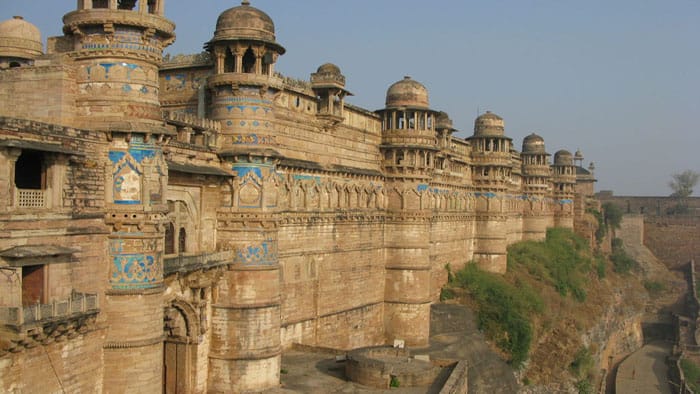
In 1886, the British took control of the whole of India and this fort had no special significance for them, so they gave it to the Scindia family. The Scindia Gharana ruled this fort until India became independent (1947) and also did many constructions including the Jai Vilas Mahal.
The fort was kept in good care, and many constructions were also done like palaces, temples, water tanks, etc. It has many palaces like Man Mandir, Gujri Mahal, Karan, and Vikram Mahal. This fort is in an area of 3 kilometers and is 35 feet high. Its walls have been built from the sides of the mountain and it has been connected with 6 minarets.
It has two gates, one in the north-east and the other in the south-west. The main gate is named Elephant Bridge and the other gate is named Badalgarh Gate. The Manmandir Mahal is located in the north-west, it was built in the 15th century and was renovated in 1648.
Main monument inside the Gwalior Fort
The fort combines many different architectural styles including the Dravidian style along with the Hindu, Buddhist, and Jain architecture. The Teli-ka-Mandir is the most famous of all the temples of the Gwalior fort. The Saas-Bahu Temples (two pillared temples which stand next to each other, one larger than the other) are also fascinating. The Man Singh Palace is one of the most amazing palaces of the Gwalior fort. The fort also houses the Gujari Mahal, Gurudwara Data Bandi Chhor, Hathi Pol, Suraj Kund, Karn Mahal, and Vikram Mahal.
Siddhachal Jain Temple
Siddhachal Jain Temple Caves was built thru the period of the 7th and 15th centuries. There are 32 Jain temples in the fort out of which eleven are faithful to the Jain Tirthankaras. The remaining ones are situated in the south of the fort. Rishabhanath or Adinath was the first Jain Tirthankara and his ideal is the highest one as its height is 58 feet 4 inches or 17.78m.
Urvashi Temple
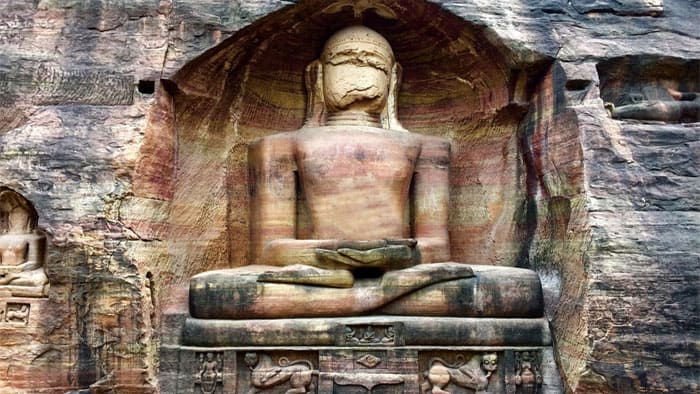
There is a temple in Urvashi fort which has many idols of Tirthankaras sitting in different postures. There are 24 idols of Jain Tirthankaras in the posture of Padmasana.
Gopachal
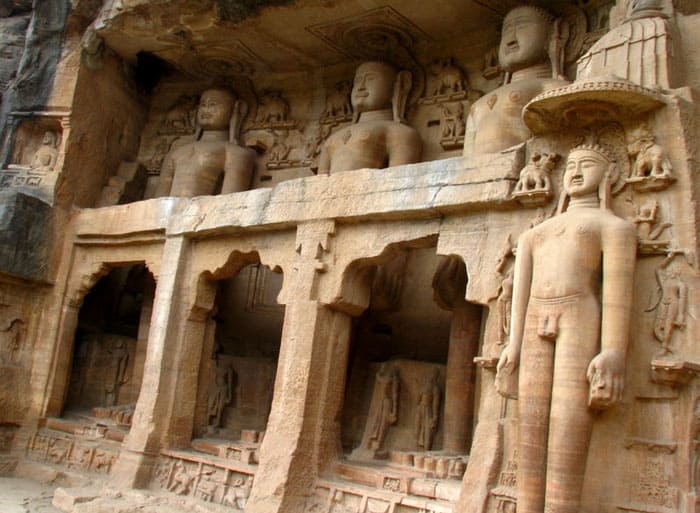
The Gopachal rock-cut Jain monuments are the carvings of Tirthankars (Jain deities) depicted in various poses, on the southern side of the Gwalior Fort. There are approximately 100 such monuments that were defaced by Emperor Babur around 1527. Today, the place is a famous Jain pilgrim center. As you go up the hill, you will also find a few small caves and rock shelters.
Teli ka Mandir
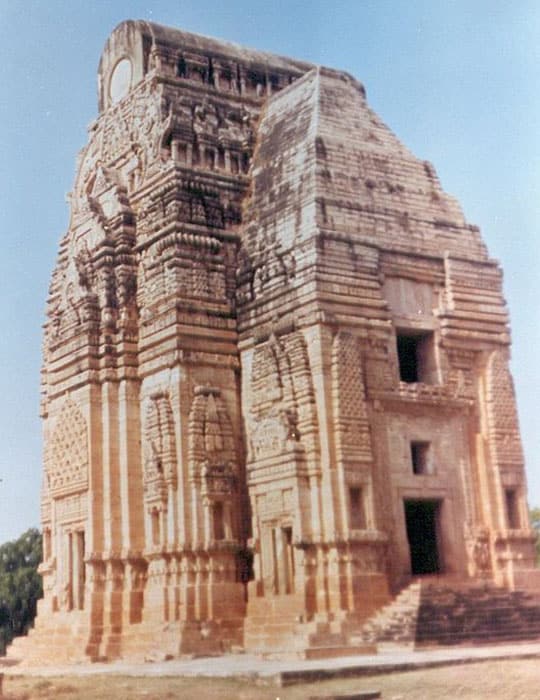
Teli Ka Mandir is dedicated to the god Vishnu, Situated inside the compound of Gwalior Fort. The ancient temple is an impressive temple and stunning monument in the Gwalior fort compound. Dedicated to Vishnu, Shiva, and Matrikas, it has been variously dated between the early 8th and early 9th century CE. It integrates the architectural elements of the Nagara style and the Valabhi Prasada that looks like the Dravidian wagon- vault topped gopuram superstructure. The temple is based on a Pratihara-Gopagiri style North Indian architecture.
Garuda Memorial
This monument is dedicated to Lord Vishnu who is the tallest in the fort. This pillar has a mixture of both Muslim and Indian architecture.
Sahastrabahu (Sas-Bahu) Temple

Sas Bahu ka mandir of Gwalior also known as Sahastrabahu Temple is the most famous temple in Madhya Pradesh. The temple is one of the greatest architectural marvels in the state.
Gurudwara Data Bandi Chhor
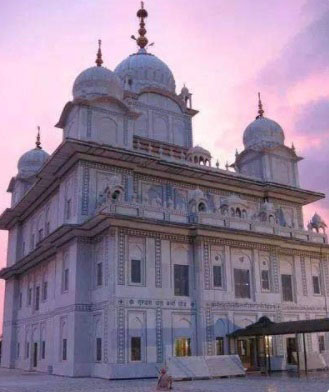
It is situated on the hilltop in the Fort Gwalior. Guru Hargobind Sahib, the 6th Sikh Guru who was imprisoned here by Jehangir for over two years. He started raising the army of Sant Soldiers to fight against the cruelty. The Gurudwara is beautiful and surrounded by colorful bougainvillea.
Suraj Kund
According to history, the water from this pond cured the leprosy of a local prince named Suraj Sen. Out of gratitude he builds a fort to protect the area and names it as Gwalior.
The palace inside the fort
Man Singh Palace
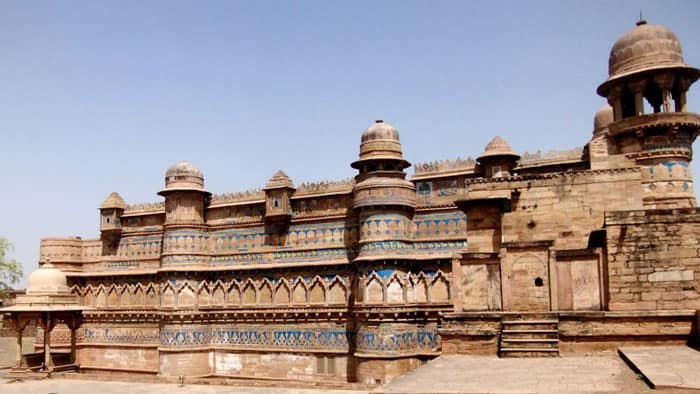
This is the most intrigued monuments you would find inside the complex of the Gwalior Fort. The Man Singh Palace was built in the 15th century by Maharaja Man Singh Tomar. It is a beautifully painted palace with green, yellow, and turquoise-colored tiles adorning its walls. It is a four-story palace with open courtyards and basement floors comprising of circular prisons. Visitors from across the world come especially to visit the palace.
Hathi Pol
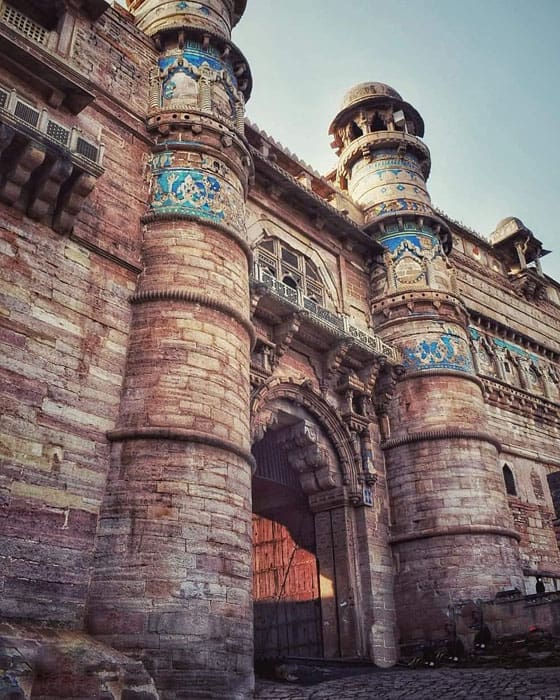
The Hathi Pol is a massive entrance that has two trumpeting elephants that form an arc and was commissioned by Rao Ratan Singh. This huge artichectural feat evokes a sense of grandeur.
Karan Mahal
Karan Mahal was built by Kirti Singh, who was the second king of the Tomar dynasty. Kirti Singh was also known as Karan Singh and hence the palace gets the name, Karan Mahal. It is one of the first places built where we can spot a darbar hall, a prison, a hamam, and similar things around.
Vikram Mahal
Vikramaditya Singh was the hoarier brother of Man Singh. He raised Vikram Mahal which was also known as Vikram Mandir because it had a temple of Lord Shiva which was ruined during the Mughal period. It is situated opposite Karana Mahal and behind the Man mandir. The palace represents a temple, so it is called Vikaram Mandir.
Chhatri of Bhim Singh Rana
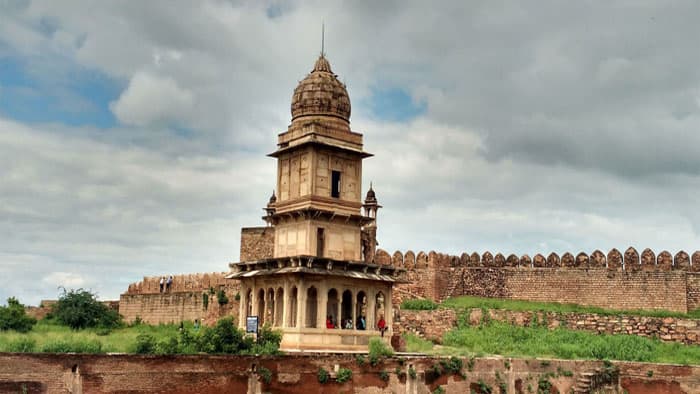
The Jat dynasty of Gauhad occupied the fort in the 16th century A.D. The Chhatri of Rana Bhim Singh is built near the Jauhar Kund. The elegance of the monument distinguishes it from many other chhatris of the period.
Gujari Mahal
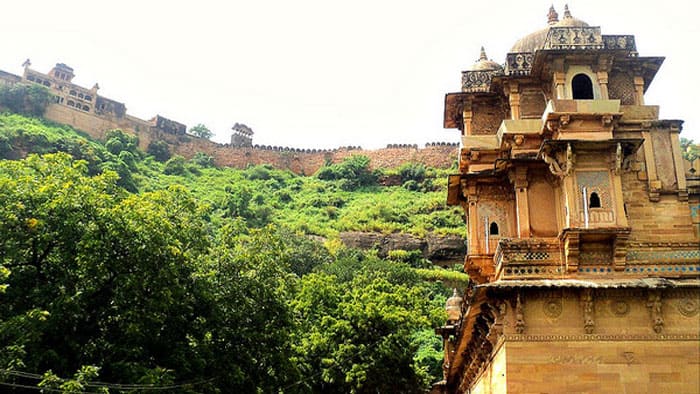
Gujari Mahal is archaeologically the most important place to visit in Gwalior. It was built by Raja Man Singh for his beloved wife, Mrignayani. Gujari Mahal was built away from the Man Singh Palace because the queen demanded a continuous water supply from the then existent river, Rai. It has now been turned into an archaeological museum and holds a collection of ancient Jain and Hindu sculptures. For a close look at the architecture of the 15th century, you must visit this amazing place.
Other monuments
Many other monuments are built inside the fort area. These include the Scindia School (originally a special school for sons of Indian princes and nobles), founded in 1897 by Madho Rao Scindia.
Some interesting facts related to Gwalior Fort
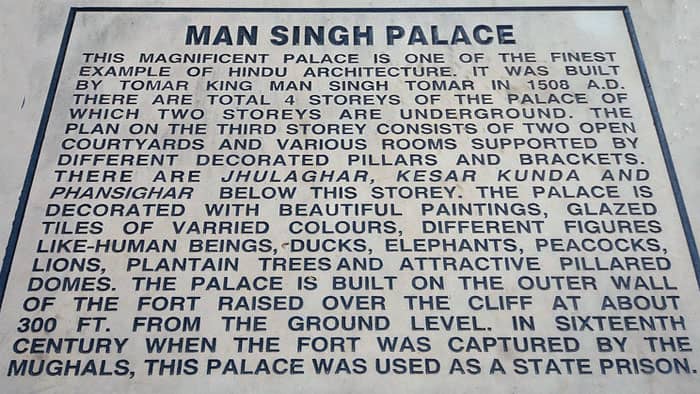
-
The second oldest record of Number “zero” was found in one of the temples inside the fort.
-
It encloses three temples, six palaces, and numerous water tanks.
-
The scared pond (Surajkund) is known for having healing qualities.
-
There are huge stone statues of Bahubali; the tallest is 17 meters in height.
-
The Gujari Mahal, which is part of this Gwalior Fort, houses the idol of the first AD.
-
There are two routes to reach the fort, Gwalior Gate and Orawai Gate.
-
The main gate of the fort is known as Elephant Pool.
-
The Teli Ka Mandir, its English version known as Oilman’s Temple is a marvelous amalgam of the architectural features of the temples of north and south India.
-
Jain statues and thousands of Jain Tirthankar idols were destroyed during the Mughal invasion.
-
The Kohinoor diamond, which is currently in Britain, was the last patron of this diamond, the king of Gwalior.
-
The fort witnessed battles fought by Rani Lakshmibai, the Queen of Jhansi.
-
On 1 June 1858, Lakshmibai along with the Marathas occupied this fort for only 15 days.
-
After independence Scindias continued their reign over the fort and constructed several monuments.
-
Gujari Mahal is now a state archaeological museum.
How to Reach Gwalior Fort
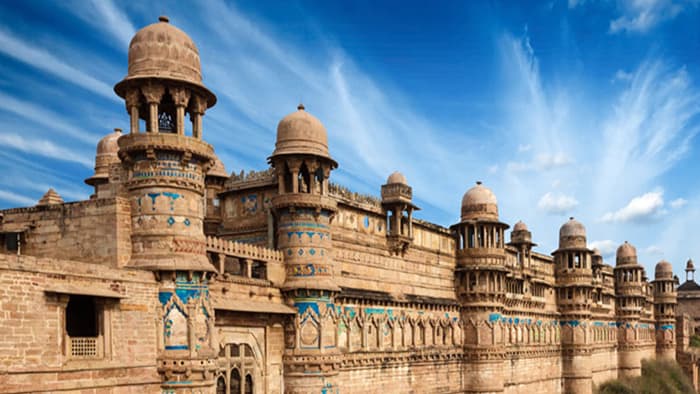
Gwalior has an only a domestic airport that is connected to many important cities of the country named as Rajmata Vijaya Raje Scindia Air Terminal. Gwalior is well connected through rail and many trains like Rajdhani, Shatabdi, superfast, express, and mail trains connect Gwalior to various major cities. You can visit Gwalior by bus MPSRTC provides bus services or hire a cab or taxi.
